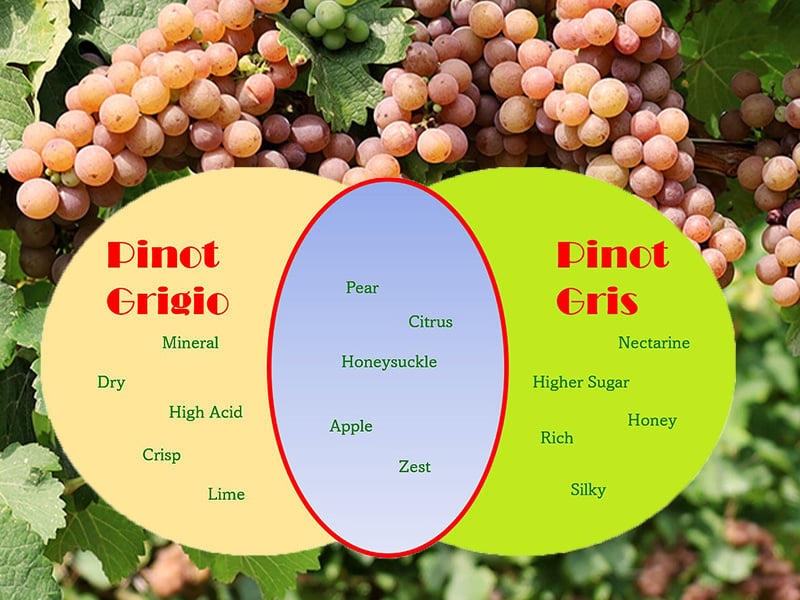Pinot Gris Vs Pinot Grigio, Revisited
- Posted on
- Posted in france, Italy, pinot gris/pinot grigio
- 0

Pinot Gris and Pinot Grigio are two names for the same grape variety. Often the produced wines will exhibit very distinct characteristic differences, due to the winemaking styles and regional influences.
Let us first consider Pinot Gris wines, whereas the name suggests it originates from France, particularly in the Alsace region. At City Vino, you may wish to explore the Michel Fonne Pinot Gris, from Alsace. It is also grown in other regions, such as Germany (where it is called Grauburgunder), Australia, New Zealand, Oregon, and California.
Pinot Gris wines are characteristically rich and full-bodied, offering a wide range of flavors that may include citrus, apple, and stone fruit notes, like peach and apricot. To achieve these flavors, both the vineyard manager and winemaker have specific choices to make. The first choice is to pick a vineyard in a warm climate which allows for longer hang time on the vine. Meaning this vineyard has a lower degree of early spring or late fall frost hazard. Some would argue that the soil composition also adds to the development of the fruit. In any case, the extended, warm season results in fruit that has a high accumulation of sugar and flavors at the time of harvest. The lengthened season also means that the acidity will drop toward harvest to about a moderate level.
In the winery, winemakers, making Pinot Gris, may use techniques such as barrel fermentation and aging on lees (dead yeast cells), which add depth, texture, and complexity to the wine. The higher sugar content, during fermentation, turns into a higher ABV level in the final product. These wines are often more aromatic, with pronounced flavors of citrus, apple, and stone fruits, and may have a richer, fuller body.
Labeling on the bottle will tell you which style the winemaker is going for. An example is The Ned from Marlborough, New Zealand. Now Pinot Gris is a pinkish-gray color. When the skins are allowed to macerate with the fruit for a while, the color will rub into the juices creating a bit of a pinkish hue, like you would do for making red wines. This not only adds color, but it also adds flavors, and tannin texture, and reduces the acidity just a little. Meaning that the hang time with the skins has caused the wine to be a fuller-body wine, like you would experience with a French Pinot Gris.
On the other hand, the term Pinot Grigio is primarily used in Italy, although it can be used in other regions as well to indicate that the wine is made in a style reminiscent of the Italian approach. An example is I Lauri Tavo or Parlovini Il Nido, where the higher acidity and clean, crisp finish is key with these wines.
Italian Pinot Grigio is typically lighter in body compared to Pinot Gris from other regions, such as Alsace or Oregon. This lighter style is often attributed to the cooler climate in the northeastern part of Italy, where the grapes grow. The cool air from the Alps helps the grapes retain more acidity as they ripen, leading to wines with higher levels of refreshing acidity. Italian Pinot Grigio is known for its light, crisp, and easy-to-drink nature, making it very popular for casual sipping and warm-weather enjoyment.
In Italy, particularly in the northeastern regions like Veneto and Friuli, the winemaking style for Pinot Grigio is typically focused on preserving the grape's natural acidity and producing a lighter, crisper, and more refreshing wine. The grapes are usually harvested earlier to retain higher levels of acidity and a fresher character. Stainless steel tanks are commonly used for fermentation and aging, minimizing contact with oxygen and keeping the wine's primary fruit flavors intact. As a result, Italian Pinot Grigio wines often showcase citrus and green apple notes, and they are lighter in body with a clean, zesty finish.
The cooler climate of northeastern Italy, particularly influenced by the nearby Alps, provides a shorter growing season. This climate helps the grapes retain more of their natural acidity and prevents overripening. The mineral-rich soils in this region can add a distinct mineral note to the wine, enhancing its crisp and refreshing character. Again, the very opposite of the Gris, the Grigio does develop sugar; it is just not the rich amount like that of the Gris. Grigio emphasizes preserving acidity and producing a lighter style, and generally has a lower alcohol content.

Comments
Be the first to comment...